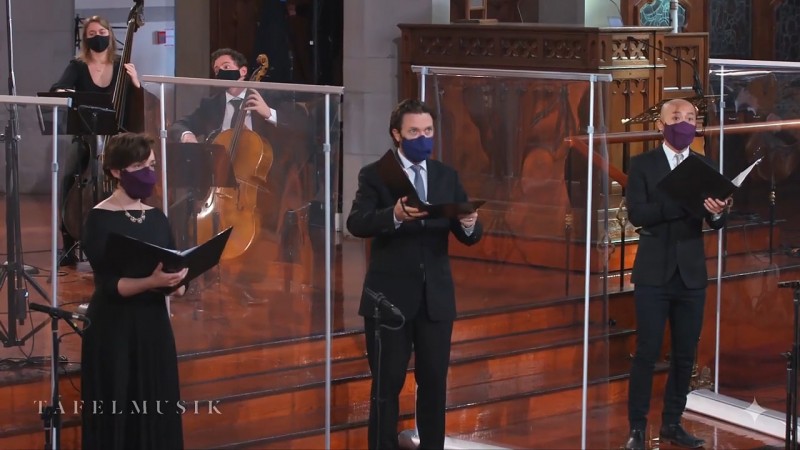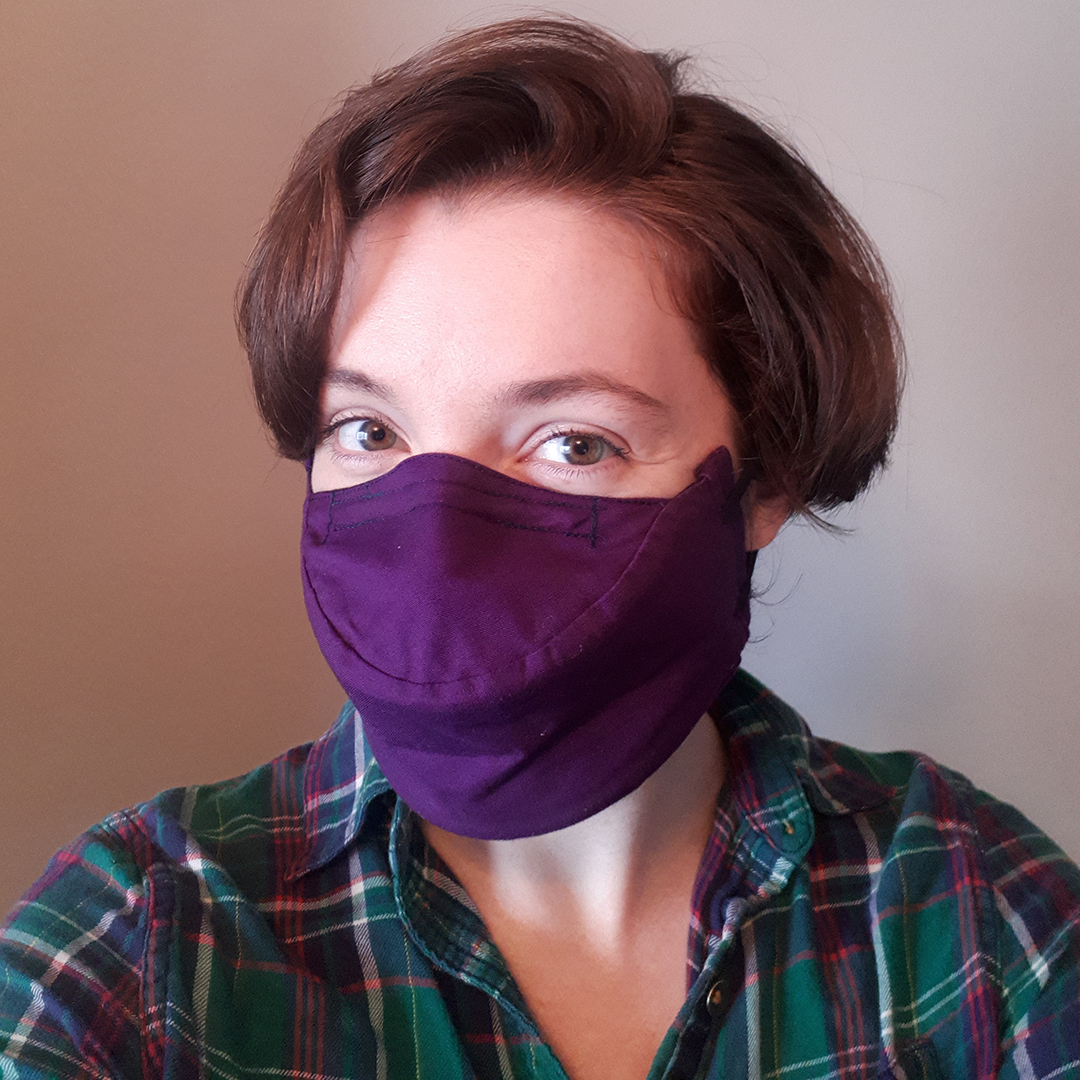Still image from A Tafelmusik Christmas
The safety of our musicians, staff, and crew is paramount to us: all of our concerts are filmed adhering to local health guidelines, and with safety in mind, which is why you will see our performers wearing masks.
But what happens when those performers are singers?
In this interview, hear from our very own choir member Katy Clark, who designed the masks worn by our choir in one of this season’s concerts.
Tafelmusik: You created masks for our choir, which were highlighted in our holiday concert, A Tafelmusik Christmas. How did this project come to be? Were you approached, or did you volunteer your help? Something else?
Katy Clark: The question of singers’ masks came up in a choir meeting over the summer, as we were all looking forward to the Christmas concert. Ivars (our Choir Director) and Carol (our Executive Director) asked if anyone had tried a singers’ mask, and it happened that I had a whole stack of them sitting beside me at the dining room table, which I had made that afternoon.
Following the meeting, they reached out for more information about the masks, and asked if I’d be willing to make a set for the choir. Of course, I agreed! Ivars generously donated the fabric and notions, and chose fabric in those beautiful purples and blues you saw in the Christmas concert.
TM: Do you have a background as a tailor, either professionally or as a hobby? How did you learn skills for mask making?
KC: My mother and two grandmothers all sewed, and I remember helping one of my grandmothers sew aprons, which she used to sell at the church bazaar, when I was very young. The first one we made together was for me, and I insisted that it had to be made out of blue gingham, like Dorothy from the Wizard of Oz. My mum would sew dresses and elaborate Halloween costumes for my sister and I when we were little, and as I got older, I would help out. Eventually, I became confident enough to make my own dresses, including several that I’ve worn for auditions and performances.
Unfortunately, I don’t usually have much time to sew, but the circumstances of the pandemic left me with lots of time to return to my sewing machine. During the first lockdown, I began experimenting with quilting, a favourite hobby of my other grandmother. One of my students introduced me to the singer’s mask pattern last spring, and I began to experiment, making masks for myself and my partner, who is also a singer. I began to get requests from musician friends, and then from actors and musicians in the community who needed singers’ masks.
Soprano Katy Clark wearing one of her own handmade singers mask
TM: We heard from Keith Lam in his New Normal interview that the masks were specially made for singers in mind. Can you explain a little bit about this? How are they constructed differently than a regular mask?
KC: As with regular masks, the key safety feature in a singers’ mask is the tight fit around the nose and chin. However, unlike regular masks, singers’ masks have two pieces of boning in them that hold the fabric out from the mouth. This allows singers to breathe more freely and move their mouths without restriction, while still providing a barrier for aerosol particles and droplets.
TM: Was there something like an existing prototype for these masks, or did you invent your own? Or a combination of the two?
KC: The pattern I use was developed by the amazing Joan Fearnley: a soprano, a choral conductor, and a tailor based in Ottawa. She has generously made her pattern available for free to anyone that needs it, and posts regular updates to the design and specifications on her YouTube page. She was very helpful as a consultant when discussing the safest options for fabric and fit.
TM: Are the materials in a singing mask different from those used in a regular mask?
KC: Following the recommendations for all masks, singers’ masks are made of quilters’ cotton and non-woven polypropylene. However, Joan Fearnley’s pattern for singer’s masks ingeniously uses zip ties in place of normal boning, which can be expensive and occasionally fussy to use.
TM: You are also a singer—and one of the newest members of the Tafelmusik Chamber Choir. How did your practice as a singer inform these masks’ creation? Did you try them and test them at home?
KC: Absolutely, I experimented quite a bit with singers’ masks in my own practice. While they are much easier to sing in than a regular mask, singing in a singers’ mask is a very different experience from singing unmasked, and it took some time to get used to.
For the first few masked practice sessions, I found myself hyperventilating a little bit, and had to accustom myself to a slightly different sensation in breathing. I also had to get used to the different acoustic phenomena that occur when singing into three layers of fabric, which tend to muffle the normal perception of resonance. The masks also create a shorter feedback loop of sound, so that I can hear myself a little too clearly when singing in a group, but have more difficulty hearing my colleagues. It took quite a bit of practice to get used to these changes!
TM: Instead of—or in addition to—singing masked, some organizations (including Tafelmusik) have also used plexiglass barriers to keep their singers safe. Are there other inventive, interesting safety measures you’ve seen used?
KC: I’ve been perpetually awed by the ways in which people are using technology to overcome the difficulties imposed by the pandemic. Not being particularly technologically inclined, moving into a world of online rehearsals, online teaching, live-streamed concerts, and at-home recordings has been a steep learning curve for me, but I’ve been very impressed by the creative things people have been able to achieve safely using technology.
I’ve begun rehearsing regularly with colleagues using low-latency platforms like Jamulus, and the results have been quite effective. I also work as an actor, and was recently part of a podcast recorded on Zoom. This was a comedy podcast, so timing was key. We met over Zoom and performed our sketches, with each of us recording our audio separately. The audio engineer tightened up the timing of our dialogue after the fact, and you’d never know we weren’t all in the same room!
TM: Can you tell us a little bit about your singing career, and what brought you to Tafelmusik?
KC: This is my first season with Tafelmusik (and what a season it has been!) In the non-pandemic world, I perform regularly as a soloist and chorister in opera, oratorio, art song, and musical theatre. This summer, I will be one of the featured soloists on an album of art song by Canadian composer Alice Ping Yee Ho, which will be recorded in August.
I am also working on my DMA in Voice Performance at the University of Toronto, where my research is focused on the four operas of John Beckwith and James Reaney. The pandemic has provided me with some much needed time to work on my dissertation. I love teaching, and I operate a private voice studio, which has migrated online since the pandemic began.
TM: Anything else you’d like to share?
KC: I can’t wait to sing with the whole Tafelmusik Chamber Choir once it becomes safe to do so! Many thanks to Ivars and the entire Tafelmusik staff for their continued dedication to keeping us safe, and for their creativity in finding ways to keep making music.


